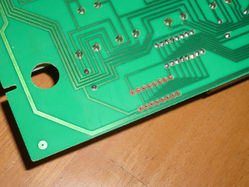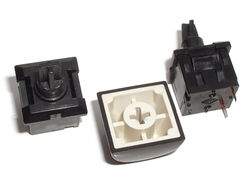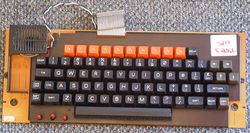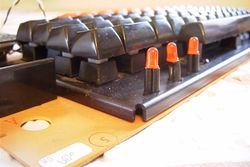Acorn BBC Microcomputer
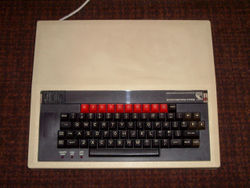 | |
| Branding | BBC |
|---|---|
| Manufacturer | Wong's, SMK, PED |
| Keyswitches |
Futaba MR-6C series SMK J-M0404 series PED keyswitch |
| Switch mount | Plate mount |
| Keycaps | Double-shot spherical |
| Interface | Proprietary internal |
The BBC Microcomputer System from Acorn Computers Ltd, commonly known as the BBC Micro or Beeb, was a series of 6502-based 8-bit microcomputers introduced in the United Kingdom in late 1981/early 1982.
Contents
Overview
Unusually for an 8-bit home computer, these computers used discrete mechanical switches, mounted in aluminium and steel plates. Switches were sourced from Futaba, PED and SMK. The three different brands of switch used different keycap mounts and the keycaps are not interchangeable between keyboard types, except presumably the two SMK types.
All the variants were supplied with spherical double-shot keycaps in a curious combination of black (technically very dark brown), flame red for the function keys, and olive drab for the cursor keys. The differences between the variants are minor.
The keyboard is integrated into the computer; it is secured by two screws and nuts and is extremely easy to remove, after removing the four screws that retain the case lid. Unusually for a plate-mounted keyboard, it is the PCB and not the mounting plate that is screwed down. The keyboard has two cables that connect to the motherboard: one ribbon cable for the matrix, and the speaker cable, as the speaker is integrated into the keyboard. The keyboard also has capacity for fitting a ROM socket, usually used for speech synthesiser ROMs, and a DIP switch bank for setting hardware configuration.
Operation
Unlike a protocol such as the AT keyboard interface, the BBC Micro keyboard does not transmit keypresses as they occur. All the matrix rows are connected at one end to a 74LS30 NAND gate,[1] which is in turn connected to CA2 (port A control line 2) of the System VIA; this control line generates the keyboard interrupt. (The VIA chips are MOS 6522 Versatile Interface Adapter ICs found on the computer motherboard.) The matrix columns are strobed continually at 1 MHz; when any key is pressed, the OS receives the interrupt signal, and takes control of the keyboard scanning. During controlled scanning, the matrix rows are sensed individually to identify which keys are pressed.[2] Detection of key release however is unexplained.
Acorn MOS supports two-key rollover; two locations in zero page (&EC and &ED) hold the non-modifier keys currently depressed, or zero otherwise.[3] Row zero of the matrix has anti-ghosting diodes fitted[1] which allows contacts in this row to be detected simultaneously with any two keys elsewhere in the matrix. Row zero contains the modifier keys shift and control and the start-up options.
Start up options
The BBC Micro has no writable, non-volatile memory. To partially alleviate this, eight bits of "start up options" can be set in hardware. These options control the default screen mode (bits 0–2, switches 6–8), reversal of shift+break (bit 3, switch 5), and diskette drive parameters (bits 4 and 5, switches 3 and 4); bit 6, switch 2, is not used.[1][4] In a machine fitted with the DNFS filing system ROM bit 7, switch 1, is used to control the default filing system should both disc and network hardware be fitted, otherwise it is not used.[5] These eight bits occupy columns two through nine of the first row of the keyboard matrix and function as keys.
Solder pads are provided on the keyboard PCB to affix a DIP switch block; alternatively the settings can be hard-wired using links. By default, each of these eight bits defaults to zero.
Keyboard types
Prior to the identification of the switches, the keyboards were classified by Chris Richardson of 8-Bit Software into four types,[4] which are not numbered in the order that they were introduced. These type numbers are used here for convenience.
Type 1
This is the original and most common keyboard type, with an aluminium plate and Futaba MR-6C series switches. This appears to have been manufactured from the 1981 to 1984. The OEM was Wong's. The keycaps were manufactured by Comptec; this is not only evident from the design, but Signature Plastics have confirmed that Wong's was a major customer.[6] "Keytop set 'Comtec'" [sic] (£20.83) and "Spacebar (Comtec)" (£0.66) are listed in a catalogue, but the specific keyboard for which it was intended is not given.[7]
Type 1a
This very similar to, and is believed to be a precursor to, the type 1. It does not have the speaker grille and the placement of some components is slighly different. The assumption is that components were moved between this and the type 1 to introduce the speaker grille.
Type 2
SMK J-M0404 series switches with angled keystems, mounted onto a steel plate. Known manufacturing dates are from 1984. The OEM was SMK, part number 401KBM-006-90RⒶ. The shift keys, space bar and possibly also tab use the brown and beige low-friction version of the switch.[4] These switches have been reported to be unreliable.[4] The keycaps were sourced from SMK, as they fit SMK's moulding style.
The return key uses a pair of low-force switches in tandem, connected together on the PCB.[8] These switches have the brown slider indicative of low friction switches, together with a beige base.
Type 3
PED keyswitches.[7] The mounting plate is aluminium. Also known to be manufactured in 1984. The PCB is not branded. The keycaps were supplied by Comptec.
Type 4
SMK J-M0404 series switches with upright keystems, on an aluminium plate. Also known to be manufactured in 1984. The OEM was Wong's. The keycaps were supplied by Comptec.
Later computers
The Acorn Electron and the original Master Series machines used Futaba low-profile linear switches. The Master Compact used conductive rubber domes over a PCB, and later Master 128s used Cherry MY switches.[4] The Futaba low-profile linear switch did not have anything close to the reliability level of the simplified linear model.
External links
- wouter.bbcmicro.net — Pictures of BBCs (Wayback Machine)
- wouter.bbcmicro.net — BBC serial numbers and dates (Wayback Machine)
References
- ↑ 1.0 1.1 1.2 Bray, Andrew C; Dickens, Adrian C; Holmes, Mark A — The Advanced User Guide for the BBC Microcomputer — pp. 489–90: Appendix J — The keyboard circuit
- ↑ Arduino Forum — BBC Micro Keyboard
- ↑ Bray, Andrew C; Dickens, Adrian C; Holmes, Mark A — The Advanced User Guide for the BBC Microcomputer — p. 142: OSBYTE &78 (120) *FX 120
- ↑ 4.0 4.1 4.2 4.3 4.4 8-Bit Software — See Their Insides
- ↑ Acorn Computers Ltd — The DNFS instruction booklet, chapter 4, page 9 (Chris's Acorns / The Centre for Computing History)
- ↑ Correspondence with Signature Plastics, 2015-10-02
- ↑ 7.0 7.1 BBC Micro Mailing List — Subject: Interesting DRAM catalogue
- ↑ Correspondence with Andrew from CJE Micro's, 2016-10-06










